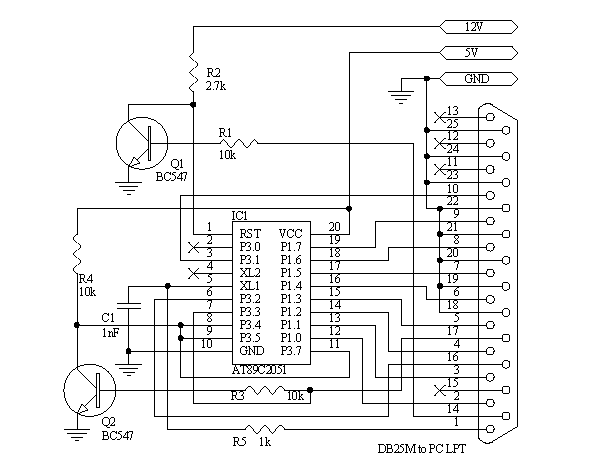
Programator Atmel At89c2051
Atmel AT89c2051, AT89c1051 and AT89c4051 are compatible with Intel 8051 Industry Standard. A lot of freeware is available (Assembler, C, Debugger and mountains of ready to use software applications on the internet).

The 8051 (also known as MCS-51) is an MCU design from the 80's that remains popular today. Modern 8051-compatible microcontrollers are available from multiple vendors, in all shapes and sizes, and with a wide range of peripherals. In this instructable we will be looking at the AT89C2051 MCU from Atmel. AT89C2051 is a small (2Kbyte Flash, 128byte RAM), cheap (~$1.40 per chip) microcontroller.
Features: • 2.7-6V operation • 15 I/O lines • 2 timers (16 bit) • Internal and external interrupts • UART • On-chip analog comparator • Up to 2MIPS with a 24MHz clock.
Atmel Flash Micro Programmer My Atmel Flash Micro Programmer Introduction: I have build my own programmer. This device can program the AT89C51 and works with it. So it can be easily adapted to programming other devices by itself. The Atmel Flash devices are ideal for developing, since they can be reprogrammed easy, often and fast. You need only 1 or 2 devices in low cost plastic case for developing.
In contrast you need 10 or more high cost windowed devices if you must develop with EPROM devices (e.g. Phillips 87C751). The AT89C2051 is the smallest 8051 member with full resources (128 Byte RAM, 2 Timer, UART).
Only the Flash size and pin count is reduced (2kByte, 20 pin case: 15 IO pins available). Now I have build a programmer for these 20 pin devices working with the AT89C2051: The programmer and the PC are connected via a serial port (COM1.4). No Interrupt is used since every data byte from the programmer must be receipt by the PC. So this program can also run under WINDOWS without data loss.
Devices: Today following devices can be programmed: • AT89C51 / AT89C52 (at 12V only) • AT89C1051 / AT89C2051 / AT89C4051 • AT90S1200 / AT90S2313 (AVR) • AT89S8252 / AT89S53 • AT89C55 • ATtiny22 (new) Features: • Input: Intel HEX (use converter to load binary) • Autodetection (read signature at 5V, can failed if device locked) • Fast parallel programming (with ready polling) • Batch mode programming • Programming lock and fuse bits • Adding new devices via definition file (PC program must not modified) • full Protection against misinsertion or misselection Using: The using is quite simple. Knigi karolini grem v. The example file 'proflash.bat' can be used for calling automatically after generating hex file to program in batch mode. In this case the target must be placed in the programmer before compiling started. Or you place 'uniprog.ini' in the same directory with the 'uniprog.exe' file and make all programming steps manually. On AVR devices the FLASH and EEPROM are programmed together. If only one name is given, the second name for the EEPROM hex file is build by exchanging the extension with '.eep'.
You can also give 2 different names for both. On using a comma to separate you can define one or both names empty. To select the device you can use the autoselect feature. You can also select it by using the up -or 'u'-key or down- or 'd'-key (using characters 'd' or 'u' in batch mode recommend). The programmer is tested under DOS or WINDOWS (3.xx or 95).
A 386SX or higher CPU is needed. Other Features: • Return an errorlevel on successful programming • Internal virus check • Baudrate detection, you must give a range e.g. Baud = 00 • The device can given by the number (entry in the definition file) or by its name (e.g. 89C51) • Prepared for universal using e.g.
For the Documents for building: These are free for non commercial using only! There is no pcb available. Since most connections are from the programmer (AT89C51) to the same pin of the target (ziff-socket), it can be easily build with an universal pcb. Only few other devices are needed. To prevent malfunction on using different versions of the programmer, load all needed documents together. • • • • • • • • • Building hints: Important: The Opamp () must meet following parameters: - Rail to rail output, - Input range include negative rail, - Slew rate 3.6V/µs or higher.